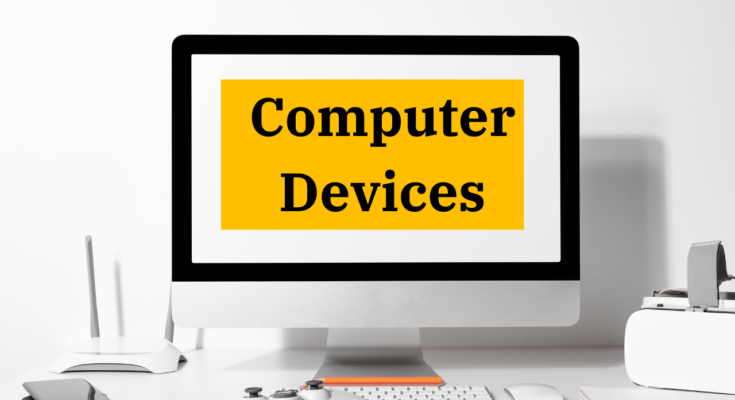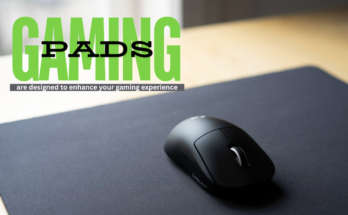Computer Devices and Peripherals Examples, Types & Uses:
Computer Devices comprises numerous components essential for its efficient functioning and operation. These Computer Devices serve as the fundamental elements that facilitate the smooth and rapid operation of an electronic device.

Each component of a computer system plays a crucial role in its overall functionality. These Computer Devices work together seamlessly, coordinating their actions to execute tasks effectively and deliver desired outcomes. From basic input/output Computer Devices to complex processing units, every element contributes to the device’s performance and usability.
1) Input devices
In the Computer Devices, an input device is a part of computer hardware device that is used to provide data and control signals to an information processing system such as a computer or information equipment.
The input devices can be named as follows:
E.g.: – Keyboard, Mouse, Mic, Scanner, RFIDBar code reader, Camera, touch screen, memory chips reader and joysticks etc.
Keyboard
The keyboard is the most frequent and popular input Computer Devices used to enter data into a computer. The keyboard layout is similar to that of a typical typewriter, with a few extra keys for performing additional operations.
- Keyboards come in two sizes: 84 keys or 101/102 keys, however keyboards with 104 or 108 keys are also available for Windows and the Internet.
The keys on the keyboard are as follows :
| S.No | Keys & Description |
|---|---|
| 1 | Typing Keys
These keys include the letter keys (A-Z) and digit keys (09) which generally give the same layout as that of typewriters. |
| 2 | Numeric Keypad
It is used to enter the numeric data or cursor movement. Generally, it consists of a set of 17 keys that are laid out in the same configuration used by most adding machines and calculators. |
| 3 | Function Keys
The twelve function keys are present on the keyboard which are arranged in a row at the top of the keyboard. Each function key has a unique meaning and is used for some specific purpose. |
| 4 | Control keys
These keys provide cursor and screen control. It includes four directional arrow keys. Control keys also include Home, End, Insert, Delete, Page Up, Page Down, Control(Ctrl), Alternate(Alt), Escape(Esc). |
| 5 | Special Purpose Keys
Keyboard also contains some special purpose keys such as Enter, Shift, Caps Lock, Num Lock, Space bar, Tab, and Print Screen. |
Mouse
The mouse is the most used pointing device. It is a well-known cursor-control gadget with a small palm-sized box and a spherical ball at its base that detects mouse movement and transmits matching signals to the CPU when the mouse buttons are pushed.
It contains two buttons, left and right, and a wheel between them. A mouse can move the pointer around the screen, but it cannot enter text into the computer.
Advantages
- Easy to use
- Not very expensive
- Moves the cursor faster than the arrow keys of the keyboard.
Joystick
Joystick is a pointing device which is used to move the cursor on the monitor screen. It is a stick with spherical balls at both lower and top ends. The bottom spherical ball travels within a socket. The joystick may travel in all four directions. The joystick functions similarly to a mouse. It is mostly used for Computer Aided Design (CAD) and computer gaming.
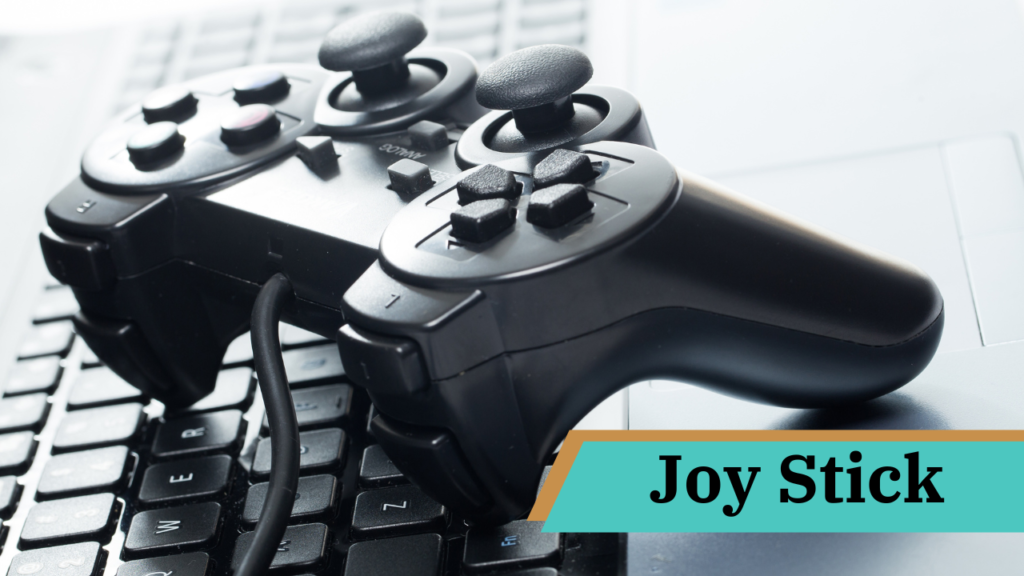
Light Pen
A light pen is a pointing device that functions similarly to a pen. It is used to pick a menu item or draw images on the monitor screen. It comprises of a photocell and an optical system housed in a tiny tube. When the tip of a light pen is moved over the monitor screen and the pen button is pressed, the photocell sensor element identifies the screen position and provides the appropriate signal to the CPU.
Track Ball
Trackballs are input devices that are commonly used in notebook or laptop computers instead of mice. This is a half-inserted ball that can be manipulated by moving the pointer with your fingers. A track ball takes up less room than a mouse because the entire gadget is stationary. A track ball comes in a variety of forms, including a ball, a button, and a square.
Scanner
Scanners are input devices that function similarly to photocopiers. It is utilized when information is accessible on paper and has to be transferred to the computer’s hard disc for further processing. The scanner collects images from the source, which are then translated into a digital format that may be saved on the disc. These photos can be altered before printing.
Digitizer
A digitizer is an input device that turns analogue data into digital form. A digitizer converts a television or camera feed into a series of numbers that may be stored in a computer. They may be utilised by the computer to build an image of whatever the camera is aimed at.
Digitizers, often known as tablets or graphics tablets, transform visuals and pictorial data into binary inputs. A graphic tablet serves as a digitizer for fine-line drawing and picture editing applications.
Microphone
A microphone is an input device that takes in sound and stores it digitally. The microphone is utilized in a variety of applications, including providing sound to multimedia presentations and mixing music.
Magnetic Ink Card Reader (MICR)
MICR input devices are widely used in banks because to the high volume of checks processed each day. Special ink containing magnetic particles is utilized to print the bank’s code number and check number on the checks, allowing for machine-readable recognition known as Magnetic Ink Character Recognition. MICR provides substantial advantages in terms of speed and accuracy.
Optical Character Reader (OCR)
OCR is an input device that reads printed text. OCR scans the text optically, character by character, turns it to machine-readable code, and saves it in system memory.
Bar Code Readers
A bar code reader is a device that reads data represented by light and dark lines. Bar coded data is commonly used for product labelling, book numbering, and other applications. It might be a portable scanner or incorporated in a fixed scanner. The Bar code scanner is used to scans a bar code picture and convert it into a alphanumeric value, which is transmitted to the connected computer.
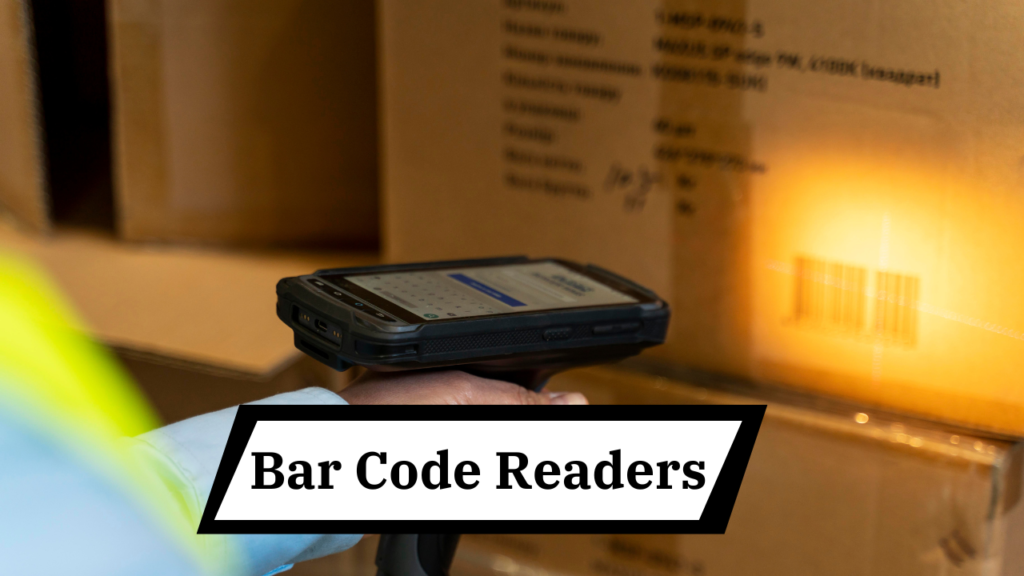
Optical Mark Reader (OMR)
OMR is a unique type of scanner which is used to recognizes the type of mark created by a pencil or a pen. It is used to pick and mark one of several possibilities. It is specifically designed for verifying the answer sheets of tests with multiple choice questions.
2) Output devices
An output device is a computer hardware component that receives data and orders from an information processing system (e.g., computer or equipment) to complete a task. This produces the outcomes of data processing performed by the information processing system, which translates electronically generated information into human-readable form.
The output Computer Devices can be named as follows:
E.g.: – Speaker, Monitor, Projector, Printer and Platter etc.
3) Processing device
A processing device is a computer component that controls data storage and retrieval. Examples of processing devices include CPUs, motherboards, network cards, graphics processors, and sound cards.
The processing Computer Devices is known as below:
E.g.: – CPU- (Control Processing Unit).
4) Storage device
Data storage refers to recording information on a storage Computer Devices. Recording may be achieved using nearly any type of energy. Examples of storage devices include DNA and RNA, handwriting, phonographic storage, magnetic tape, memory chips, and optical discs. Electrical power is required for electronic data storage and retrieval. Digital data refers to information stored in a machine-readable format. One of a general-purpose computer’s primary duties is to store computer data. Electronic papers may be kept in significantly less space than paper documents.
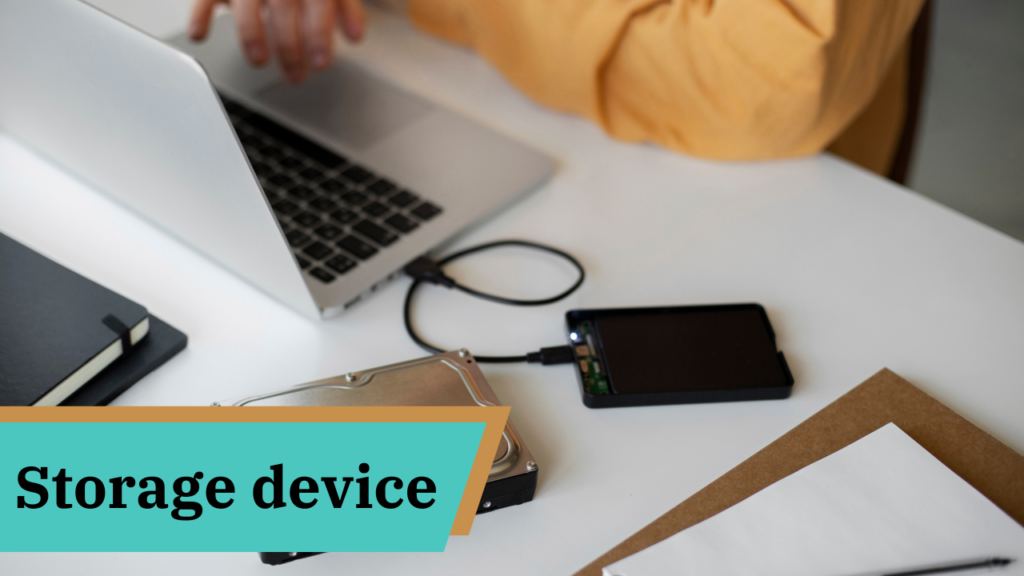
Storage Computer Devices are broadly classified into two types, as shown below.
Primary storage device
Note: – The Primary Storage Computer Devices is temporarily or permanently stored the information/data in a device that they are known as below:
I) Temporary storage device
Random-access memory (RAM) is a type of computer storage that holds current data and code. A random-access memory device enables data objects to be read or written in about the same amount of time, regardless of their physical position within the memory. This is why RAM is considered transitory memory.
II) Permanent storage device
ROM, or read-only memory, represents a class of nonvolatile memory present in computers and various electronic gadgets. Primarily, it serves the purpose of housing firmware software intricately tied to particular hardware, thus obviating the need for routine updates or application software, often stored in plug-in cartridges. ROM encompasses diode matrix and mask ROM (MROM), both forms being hard-wired and incapable of alteration post-installation.
In recent years, read-only memory (ROM) has expanded to offer reprogrammable options. Erasable programmable read-only memory (EPROM) and electrically erasable programmable read-only memory (EEPROM) enable erasing and reprogramming, however at slower rates and with specialized equipment. Additionally, they have a finite amount of erase and rewrite cycles.
The Permanent Storage Computer Devices is known as below:
E.g.: – ROM (Read Only Memory)/BIOS (Basic Input Output System).
B) Secondary storage device
Secondary storage devices expand a computer’s primary storage capacity, which includes RAM and cache memory. They are capable of handling data ranging from small bits to massive petabytes. These devices store nearly all programs and applications on a computer, including the operating system, device drivers, software applications, and user data. Some secondary storage devices are integrated into the computer, like the hard drive, compact disc drive, and floppy disc drive, though the latter is now obsolete.
The secondary storage device is known as below:
E.g.: – Hard disk, Floppy disk, CD- (Compact Disk), Pen/Flash drives, Memory/Microchips, cassettes/Magnetic tape, DVD- (Digital Video Disk) and External Hard Drives etc.
Conclusion:
Finally, Computer Devices and peripherals include a wide range of components required for proper device performance. Each component, from simple Input Computer Devices like as keyboards and mouse to complicated processing units and Storage Computer Devices, is critical to ensuring smooth and speedy performance. Computer Devices work together to efficiently complete tasks and provide the intended results. Computer technology is always evolving, with breakthroughs such as reprogrammable ROMs and secondary storage expansion, providing increased capabilities and user experiences.
